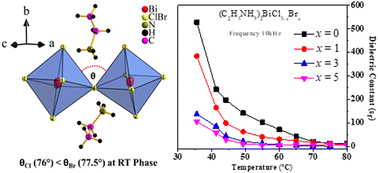(C2H5NH3)2BiCl5−xBrx perovskites containing 1D chains: effect of Br substitution on their structural and optical properties†
Abstract
Herein, we report the synthesis of the solid solutions of 1D lead-free halide perovskites, (C2H5NH3)2BiCl5−xBrx (x = 0–5), using a solution method. All the synthesized compounds adopt the orthorhombic Cmca space group at room temperature (RT) (293 K) and undergo a phase transition to a low symmetry orthorhombic space group, Aba2, at a low temperature (LT) of 90 K. All the structures contain BiX6 (X = Cl or Br) corner-sharing polyhedra, forming zigzag 1D chains. The symmetry breaking phase transition from Cmca (293 K) to Aba2 (90 K) is due to the ordering of the ethylamine (removal of mirror plane) unit caused by strong H-bond formation in the low-temperature phase (LT phase). The TGA analysis indicates that (EA)2BiCl5 (EA = C2H5NH3+) is less stable than its bromine analogue. Optical studies show that all the compounds are of indirect band gap type with a band gap of 3 eV for the pristine chlorine compound and 2.5 eV for the pristine bromine compound. The band gap value gradually decreases with the incorporation of bromine at the chlorine site, following Vegard's law. According to the dielectric measurement, the pristine chlorine compound (x = 0) has a dielectric constant (εr) of 530, whereas that of the pristine bromine compound (x = 5) is 106 at room temperature and 10 kHz frequency.



 Please wait while we load your content...
Please wait while we load your content...